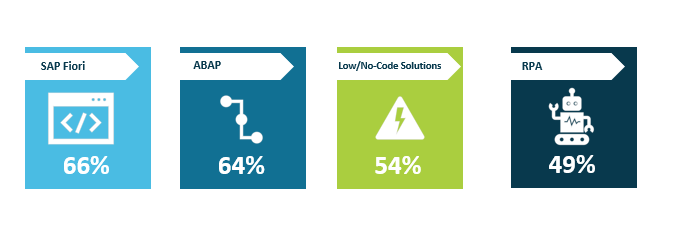The SAP partner community has received plenty of anecdotal information that enterprise resource planning (ERP) systems and custom code go hand in hand. Experience tells us that businesses often require specialized applications to optimize their one-of-a-kind processes and interactions. However, we decided to dig deeper to learn exactly how common it is for SAP users to develop custom code.
In Q2 2021, the American SAP User Group (ASUG), along with Pillir, surveyed 110 professionals, primarily in the U.S. and Canada. ASUG asked these survey respondents who work in SAP functional, enterprise architect, and SAP application development roles questions to help us better understand how many businesses use custom code and how important it is to their operations.
We found an overwhelming majority – 91% -- of SAP users rely on custom code to enable or manage essential business processes.
Additionally, 57% of organizations report that up to 50% of their mission-critical business processes currently depend on custom code that interfaces with SAP, and 13% say more than 50% of essential processes are facilitated by custom code.
We also confirmed that using custom code is a long-standing practice: 45% of the organizations we surveyed say their most valuable custom code was deployed six or more years ago. In most companies, the people who developed these apps and understand their business logic, have long moved on and are no longer developers in the organization.
The survey also found that most custom code is written in SAP Fiori (66%) or Advanced Business Application Programming (ABAP), SAP’s programming language (64%), while 54% of custom code was created in a low-code/no-code application development platform, and 49% by robotic process automation (RPA). Read more about Low code vs RPA.

What Drives SAP Custom Code Development?
Our survey confirms that companies use custom code across lines of business, from finance, payroll, and HR to procurement, supply chain management, and production – commonly wherever the business needs to monitor and control costs or manage goods.
The most common reasons that businesses in our survey develop custom code include:
- Providing unique user experiences, 50%
- Meeting regulatory requirements, 46%
- Enabling innovation, 45%
- Addressing regional differences, 35%
- Building a competitive edge, 32%
- Creating a core for digital transformation, 29%
The Downside of SAP Custom Code
Although businesses develop custom code to operate more efficiently, make regulatory compliance easier, and pave the way for innovation, they sometimes experience hurdles that prevent them from fully achieving those goals.
The survey found that 33% of businesses are challenged to find the expertise they need to maintain and enhance custom code. This issue is compounded when code has been developed years before and the business lost IT tribal knowledge to employee turnover or attrition.
Additionally:
- 63% say custom code creates barriers to upgrading or migrating to new SAP offerings.
- 31% feel it is a barrier to good security practices.
- 21% see it as a barrier to innovation.
Costs associated with custom code are also significant. Among the organizations we surveyed, their average spend is $815,857 per year to maintain their most valuable SAP custom code.
For 37% of organizations, this represents up to 50% of their annual IT spend.
Businesses Migrating to S/4HANA or Other Cloud Platforms Need a Better Strategy to Build and Maintain SAP Custom Code
Although 70% of survey respondents are focused on standardizing business processes in SAP, part of their strategy is to continue to use custom code that interfaces with SAP. Additionally, 67% say they plan to use custom code with SAP S/4HANA or when migrating to the cloud, primarily to meet unique business needs. Whether they will use custom code on-premises or in the cloud, organizations are challenged to maintain, update, or migrate those applications as their digital transformation progresses.
Technology can ease this burden. Diagnostic tools are available that can provide detailed breakdowns of an organization’s custom code, revealing what can be standardized, what the organization can migrate to a new SAP environment, and what is no longer necessary.
Furthermore, low-code development technology that enables visualizing and mapping code allows SAP users to transform ABAP to a cloud or mobile app, overcoming barriers, such as loss of tribal IT knowledge and the need to rebuild the application from scratch.
Our final thoughts on Custom Code
Our survey confirms that SAP custom code has become a part of doing business. However, it doesn’t have to create a burden or stand in the way of innovation.






 Back
Back/Logo%20-%20black%20text%20blue%20pillar%20(large)-1.jpg)

